Gandhara Civilization › Ganesha › Roman Citizenship » Origins and History
Articles and Definitions › Contents
- Gandhara Civilization › Ancient History
- Ganesha › Who Was
- Roman Citizenship › Antique Origins
Ancient civilizations › Historical places, and their characters
Gandhara Civilization › Ancient History
Definition and Origins
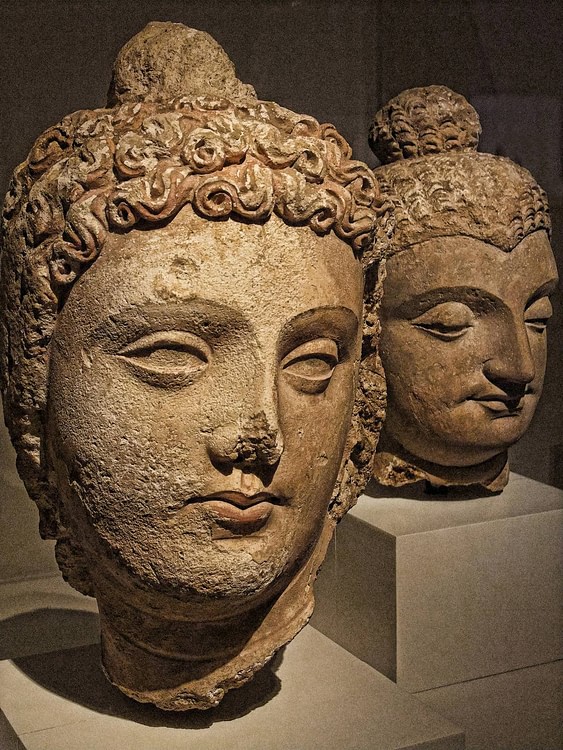
Gandhara was the name given to the land and its associated civilization that existed in what is now northern Pakistan and Afghanistan from the mid 1st millenium BCE to the beginning of the 2nd millenium CE and consisted of multiple dynasties which ruled over the same area but which were linked by their adoption of Buddhism as a religion for the most part and also of the Indo-Greek artistic tradition as its cultural identity.
THE EXTENT OF GANDHARA
Although Gandhara has been historically known since the Achaemenian Empire and more specifically during the reign of Cyrus the Great (558-28 BCE), it wasn't until the pilgrimage of XuanXang in the 7th century CE, at the tail end of the Gandhara civilization, that we first see a descriptive account of the region down to the extent of the area itself as well as the various places and sites which can be identified today.
It has been speculated that Ganhara was a triangular tract of land about 100 kilometers east to west and 70 km north to south, lying mainly to the west of the Indus River and bounded on the north by the Hindukush Mountains. (1 li = 500 meters or 1640 feet)
The extent of Gandhara proper actually included the Peshawar valley, the hills of Swat, Dir, Buner and Bajaur, all of which lie within the northern bounds of the modern day nation of Pakistan. However the bounds of Greater Gandhara (or regions where the cultural and political hegemony of Gandhara held sway) extended towards the Kabul Valley in Afghanistan and the Potwar plateau in the province of Punjab in Pakistan, in close proximity to the capital city of Islamabad, and bounded off by the location of the grand Mankiyala Stupa on the outskirts of the capital.

Map of Gandhara
ORIGIN OF THE NAME GANDHARA
The name of Gandhara may have several meanings the most prominent theory relates its name to the word Qand/Gand which means "fragrance" and Har which means 'lands' hence the simplest definition being 'Land of Fragrance'. However, when analysed critically, the region known as the core of Gandhara around the Peshawar valley does not historically have any historically verifiable association or importance with regards to fragrance, either through flowers, spices, foods etc.
Another more probable and geographically supported theory is that the word Qand/Gand is evolved from Kun which means 'well' or 'pool of water' and indeed the word Gand appears with many other place names associated with water ie Gand-ao or Gand-ab (pool of water) and also Gand-Dheri (water mound). Tashkand (stone walled pool) and Yarkand are also associated names and hence it holds to reason that the land could have been known as 'Land of the Lake(s)' as this signifies the region between the Indus and Kabul rivers which was a fertile region rich in water supplies and especially around Peshawar.
POLITICAL HISTORY OF GANDHARA
Gandhara witnessed the rule of several major powers of antiquity as listed here:
- Achaemenids (~600-400 BCE)
- Greeks (~326-324 BCE),
- Mauryans (~324-185 BCE),
- Indo-Greeks (~250-190 BCE),
- Scythians (~2nd century to 1st century BCE),
- Parthians (~1st century BC to 1st century CE),
- Kushans (~1st to 5th century CE),
- White Huns (~5th century CE)
- Hindu Shahi (~9th to 10th century CE).
This was followed by Muslim conquests by which time we come to the medieval period of Indian History.
ACHAEMENIDS & ALEXANDER
Darius I added Gandhara to the Achaemenid Empire around 556 BCE but his occupation of it did not last long. Later on it was instead known to be a tributary state of the Achaemenids (known as a satrapy) and later paid tributes and inferred hospitality to Alexander the Great who eventually conquered it (along with the rest of the Achaemenian empire ).The Achaemenian hegemony in Gandhara lasted from the 6th century BCE to 327 BCE.
Alexander is said to have crossed through the area of what is called Gandhara to enter into Punjab proper (as indeed this region is still used today for the same function) and he was offered alliance by the ruler of Taxila Ombhi, against the king Porus, who was a constant source of agitation for Taxila and its surrounding regions. What happened after this at the Battle of Hydaspes is (quite literally) ancient history. Nonetheless, Alexander's stay here was short and he went south via the Indus River and crossed over into what is today Balochistan on the return journey.
Alexander left sizeable populations of Greeks in every region he conquered and Gandhara was no exception, with craftsmen, soldiers and other followers encouraged to inter-marry and blend with the locals and bring to them the fruits of Greekcivilization. When Alexander died in June 323 BCE, his occupying Greek force, desperate to return home, started the journey back regardless of the orders to stay in the region and this left a large vaccuum in the already thinly spread Greek occupation force in Gandhara. Nonetheless, enough Greek centers were created in the region to affect its history for centuries to come.
MAURYAN RULE
By 316 BCE, King Chandragupta of Magadha (321-297 BCE) moved in and conquered the Indus Valley, thereby annexing Gandhara and naming Taxila a provincial capital of his newly formed Mauryan Empire. Chandragupta was succeeded by his son Bindusara, who was succeeded by his son Ashoka (who had previously remained a governor of Taxila for some time).Ashoka famously propagated the spread of Buddhism, and created a grand monastery to the east of the river Tamra at Taxila.This is the Dharmarajika Monastery, famous for its stupa, and it is said Ashoka buried several relics of Buddha there. However the Mauryan empire disintegrated after Ashoka's death and Gandhara was again up for grabs.

Maruyan Empire
INDO GREEKS
In 184 BCE, the Greeks (who had remained strong in Bactria, modern North Afghanistan), invaded Gandhara again under king Demetrius and it was he who built a new city on the opposite bank of the river from Bhir Mound. This new incarnation of Taxila is known now as Sirkap (meaning 'severed head') and it was built according to the Hippodamaean plan following a gridiron pattern.
The Kingdom of Demetrius consisted of Gandhara, Arachosia (modern day Kandahar in Afghanistan), the Punjab, and a part of the Ganges Valley. It was a multi-ethnic society, where Greeks, Indians, Bactrians and Western Iranians lived together.Evidence of this is found all over 2nd century BCE Taxila, such as a Zoroastrian sanctuary at Jandial, directly north of Sirkap.

Graeco-Bactrian Empire
SCYTHO-PARTHIANS
The gradual takeover of the Punjab by the nomadic Scythians of Central Asia began around 110 BCE. These tribes had been accustomed to invading northern territories such as those in Bactia, but had been kept back by the Achaemenids in the past.They had settled in Drangiana, modern day Sistan in Iran and invaded Punjab, infiltrating through the southern Indus Valley, eventually taking over Taxila.
In the first quarter of the 1st century CE, the Parthians moved in and began taking over the Greek Petty Kingdoms in Gandhara and Punjab. Gondophares, a Parthian leader who lived at Taxila is said to have been baptised by the apostle Thomas, not a wholly impossible claim since the city already hosted a number of religious faiths and might have accomodated a fledgling Christian one.
KUSHANS
In 80 CE, the Kushans wrested control of Gandhara from the Scytho-Parthians. The main city at Taxila was again refounded at another site and the new name Sirsukh given to it. It resembled a large military base, with a wall 5 km long and no less than 6 metres thick. It now became a hub of Buddhist activity, and hosted pilgrims from Central Asia and China. The Kushana era is the high point of Gandhara art, architecture and culture and considered a golden age in the history of this region. The Kushans were a tribe that migrated to Gandhara around the 1st century CE from Central Asia and Afghanistan. The tribe selected Peshawar as its seat of power and later expanded east into the heartland of India to establish the Kushan Empire, which lasted until the 3rd century CE.

Kushan Empire & Neighboring States
The Greek philosopher Appolonius of Tyana also visited the city of Taxila and compared its size to that of Nineveh in Assyria.A description of Taxila (probably Sirsukh) can be found in the Life of Appolonius of Tyana by the author Philostratus:
I have already described the way in which the city is walled, but they say that it was divided up into narrow streets in the same irregular manner as in Athens, and that the houses were built in such a way that if you look at them from outside they had only one storey, while if you went into one of them, you at once found subterranean chambers extending as far below the level of the earth as did the chambers above. (Philostratus, Life of Apollonius, 2.23; tr. FC Conybeare)
The tail end of the Kushan rule saw a succession of short lived dynasties taking over control of the Gandhara region, and this resulted in a situation where the region was constantly being raided, invaded or in some way or other in turmoil. Quick succession of rule by the Sassanids, Kidarites (or little Kushans) and finally the White Huns following the ebbing of Kushan rule led to day to day religious, trade and social activity coming to a standstill. In about 241 CE, the Kushans were defeated by the Sassanians of Persia under the kingship of Shahpur 1 and Gandhara became annexed to the Persian Empire. However, the Sassanians could not directly rule the region due to being taxed on their western and northern borders and control of this region fell to descendants of the previous Kushans who came to be known as the Kidarites or Kidar Kushans which literally means little Kushans.
WHITE HUNS
The Kidarites managed to maintain a hold of the region, carrying on the traditions of their predecessors the Kushans up to the middle of the 5th Cent CE when the White Huns or Hephthalites, invaded the region. As Buddhism and by extension the Gandhara culture was already at an ebb by this time, the invasion caused both physical destruction and, due to the Huns' adoption of the Shivite faith (most especially of their ruler Mihirakula) and by extension the culture of the Hindu Gupta empirewhich at this time was ascendant, the importance of Buddhism began to wane with even more speed.
During the White Hun invasions, the religious character of the region shifted gradually towards Hinduism and Buddhism was shunned in the favor of Hinduism as it was deemed politically expedient by the White Hun rulers since they sought to make alliances with the Hindu Gupta Empire against the Sassanids to the West. The change in religious character (which was the basis of all social life) led to a decline in the prosperity of the Gandhara region as a whole.
The White Huns' alliance with the Gupta empire against the Sassanians also caused the culture of Buddhism to be subdued to the extent that eventually the religion moved north up through the northern passes into China and beyond. Hinduism hence took sway over the region and the people moved away from here, as the remaining few centuries saw constant invasions from the west, especially Muslim conquest, which allowed no prominent culture to develop or be sustained along the ancient lines.The old cities and worship places of importance hence fell out of memory for the next 1500 years until they were rediscovered in the mid 1800's CE by colonial British forces.

White Hun (Huna) Empire
Gandhara, then, has had multiple rulers over the centuries but archaeological evidence shows us the uniformity of its cultural tradition persisted during these changes in rule. Although the territories were spread over vast areas, the cultural boundaries of regions such as Mathura and Gandhara were well defined and allow us to identify it uniquely today.
GANDHARAN ART
The beginnings of Gandharan artistic tradition can be traced to the 1st century BCE with the waning of the tradition occuring approximately in the 8th century CE and included painting, sculpture, coins, pottery and all the associated elements of an artistic tradition. It really took flight during the Kushan era and especially that of the King Kanishka during the 1st Century CE who deified the Buddha and arguably for the first time introduced the Buddha image which went on to become so prolific as to define the entire Gandharan culture. Thousands of these images were produced and were scattered across every nook and cranny of the region ranging from minute hand held buddhas to giant monumental statues put in place in the most sacred worship sites.
Indeed it was during Kanishka's time that Buddhism saw its second revival after Asoka. The life story of the Buddha became the staple subject matter for any and all aspects of Gandharan art, and the sheer number of Buddha images ensrhined in chapels, stupas and monasteries continue to be found in great number to this day. The artwork was solely dedicated to the propagation of religious ideals to the extent that even items of everyday use were replete with religious imagery. The focus was on the life story of the Buddha and each piece of sculpture has something to say about the life of this personage.
The materials used were either kanjur stone finished with plaster and paint or Schist stone. Kanjur is basically fossilized rock which can be easily molded into shapes which are used as a base for various decorative elements in Gandharan art such as pilasters, Buddha figures, brackets and other elements. After the basic shape has been cut out of stone, this is then plastered with lime plaster to give it a finished look. Gold leaf and precious gems were also applied to select items of great performance and the quality of the artwork varied depending on its use. The maximum size that the schist stone was able to be crafted into was 2.5m square in order to have it be easily transported and hence the larger statues and reliefs are made of clay and stucco.
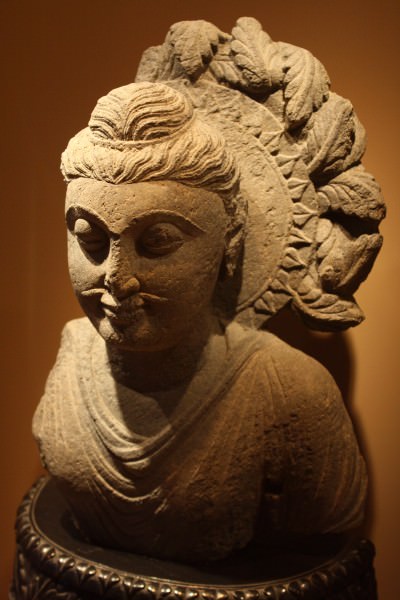
Gandhara Buddha
The Buddha was worshipped through these sculptural representations which had a distinct style associated with them that remained largely constant with some changes owing to skill or craft being seen. The Buddha is always depicted in simple monastic robes, with his hair tied in a bun known as the Ushnisha and the expression on his face is almost always one of content. Whereas originally these sculptures were painted in bright colors, now only the plaster or stone remains and barely a handful of items have been found with their original colors intact. Various cult images of the Buddha were made for the varying cults in the region all of which had their own distinct identifying features namely the Laksanas (divine marks), Mudras (hand gestures) and various kinds of robes.
Whatever the case was, Buddha always had the central role in these pieces and can be immediately identified by the halo and his simple attire. Many mythological figures are also seen as a part of these scenes along with couples, gods, demigods, celestials, princes, queens, male guards, female guards, musicians, royal chaplains, soldiers and also common people. More so, Gandharan art recreates these scenes in such detail that architectural elements and items of everyday use such as beds and vases etc. can be clearly seen in them and also give a glimpse into the building culture of antiquity. Gandharan art can thus provide us with an insight not only one aspect of the ancient life of the region but also of the entirety of the ancient buddhist daily life.
One of the most enduring elements of Gandharan art besides the Buddha is the Bodhisattva, which is essentially the state of the Buddha before he attained his enlightenment. Multiple Bodhisattvas from the various previous lives of the Buddha are depicted in Gandharan art with Avalokatishvara, Matrya, Padmapani and Manjsuri being prominent. Compared to the austerity of the Buddha images, the Bodhisattva sculptures and images depict a high degree of luxury with many variations on the various elements such as jewelry, headdress, loincloth, sandals and so on and the various incarnations of the Bodhisattva are recognisable from their clothing and postures, mostly of the hands in the seven mudras.
GANDHARAN ARCHITECTURE
Much can be said about the architectural tradition of Gandhara but the most prominent and unique characteristic of it was the proliferation of stupas and other associated religious establishments such as monasteries which formed the core of the regional identity for nearly 1000 years.
The Stupas were built mainly for the reverence of the remains of Buddhist masters and the most important ones held the remains of the Buddha himself. Besides the Buddha, monks of high stature were also venerated by having stupas built for them and these edifices also marked the places where certain legendary events related to the various lives of the Buddha were said to have occured. The proliferation of stupas across India is said to have been the hallmark of Asoka's rule who reinterred the ashes of the Buddha in multiple stupas all across his kingdom.
Even though it was mainly an architectural feat, the stupa nonetheless was a vessel for the display and worship of the prolific Gandharan art, encompassing sculptures, reliefs, paintings and other highly decorated elements that encased the structure and added immensely to not just its beauty but its veneration as a religious site. These images stood against walls, in courts, inside niches and chapels and stuccos adorned the walls of the stupa courts and monasteries.
Stupas were initially built with circular bases and were of modest size, but as the cult of the Buddha grew in importance in the region, these centers of worship were elaborately designed and adorned to boost the stature of the religion and to attract more worshippers. The original stupas at Kunala and Dharmarajika were small affairs which were later on expanded to grand proportions by rulers such as Asoka and Kanishka.

Stupa - Labelled Isometric View
The stupa was the main center of worship and in support it had the monastery, a structure with its own fully contained living area for monks. The monastery or Sangharama became a huge part of the Buddhist tradition and over time came to be its own self-sustaining unit, with lands for growing crops and wealth showered on them by lay people and royalty alike for their blessings. In its final form the monastery had some defined elements which suited its basic functions and these were:
- • Refrectory/Service Hall: Upatthana-sala
- • Kitchen: Aggi-sala
- • Cloistered Promenade: Chankamana-sala (for walking/exercise)
- • Bathroom: Jantaghara next to the central water tank
- • Store room: Kotthaka
- • Medical and general storage: Kappiya-kuti
These buildings were usually rendered in mud plaster and this was then painted over either completely or like in some cases (as in the monastery of Jina Wali Dheri in Taxila) scenes of buddha's life.

Buddhist Monastery Plan (Gandharan)
Aside from these religious buildings there was of course civic architecture as well which varied and changed with respect to the cultural prevalent in the region. Cities ranged from freely-planned organic settlements such as Bhir to the more rigid and planned out settlements like Sirsukh, with the city of Sirkap somewhere in between in terms of planning and layout.
The older cities tend to be more organically laid out while the newer ones seem to be very directly inspired by the Greek Hippodamian plan which surfaces later on in the 1st cent BCE. Shops, promenades, palaces, temples, sundials, hovels, huts, villas, insulae, pavillions, streets, roads, watchtowers, gates and fortification walls, all form part of the urban fabric which is true of most ancient cities as well.
Although the religious landscape was dominated by the Buddhist faith, there has is nonetheless ample evidence of other faiths intermingling and thriving in the social fabric such as Jainism, Zoroastrianism and early Hinduism amongst the various other cults. The temple at Jandial is said to be Zoroastrian in nature whereas a Jain temple and a temple of the Sun is in evidence on the main street of Sirkap city along with various stupas.
One of the most well known remains is the Double Headed Eagle stupa in Sirkap which contains its namesake motif of the double-headed eagle affixed on three different type of decorative arches namely the classical greek, persian and indian style of arch. This shows the degree of intermixing of cultures in the region which we can deduce from the archaeological remains.

Double-Headed Eagle Stupa
CONCLUSION
As we can see, daily life in the cities of Gandhara was very diverse and due to its location at a crossroads near to the Indus River, it constantly saw invaders, traders, pilgrims, monks and every other type of traveller cross through its lands. Westwards from India or Eastwards from Persia, the route through the region of Gandhara made it the center of every traveller's route.This is the same route through which Islam entered the region and probably struck the final nail in the coffin of Buddhism in the area. In fact the same route would be used for centuries even after Gandhara collapsed until the coming of the voyages of discovery and the prominence of naval travel via sea routes.
The riches of Gandhara, although well known to treasure hunters for centuries, would not be discovered again for over 2000 years until the era of British Colonial rule in the Indian Subcontinent, where the artistic traditions of this lost civilization were rediscovered and consequently researched and bought to light in the late 19th and throughout the 20th centuries CE, the study of which continues to this day.
Ganesha › Who Was
Definition and Origins
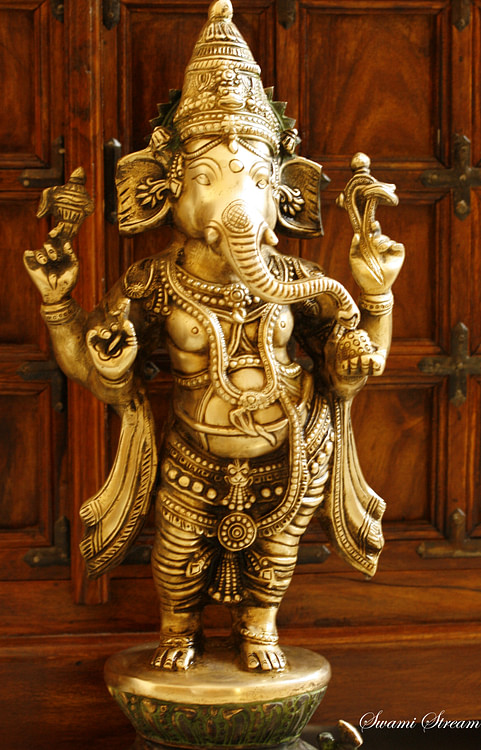
Ganesha (also known as Ganesa or Ganapati) is one of the most important gods in Hindu mythology and he is also worshipped in Jainism and Buddhism. For the Ganapatya Hindu sect, Ganesha is the most important deity. Ganesha is highly recognisable with his elephant head and human body, representing the soul ( atman ) and the physical ( maya ) respectively. He is also the patron of writers, travellers, students, commerce, and new projects (for which he removes obstacles from one's path) and is rather fond of sweets, to the slight detriment of his figure.
EARLY LIFE
Ganesha is the son of Shiva and Parvati and he is the brother of Karthikeya (or Subrahmanya), the god of war. He was created by his mother using earth which she moulded into the shape of a boy. As Shiva was away on his meditative wanderings, Parvati set her new son as guard while she bathed. Unexpectedly, Shiva returned home and, on finding the boy, and outraged at his impudence in claiming he was Parvati's son, Shiva called for his gang of demons, the bhutaganas, who fought ferociously with the boy. However, the youngster easily held his own against such fearsome adversaries and Vishnuwas forced to intervene in the form of Maya and, whilst the boy was distracted by her beauty, the demons, or Shiva himself, lopped off his head. At the commotion, Parvati ran from her bath and remonstrated with Shiva for so summarily killing their son. Repentant, Shiva ordered a new head to be found for the boy and, as the first animal available was an elephant, so Ganesha gained a new head and became the most distinctive of the Hindu gods. As a reward for his great courage in fighting the demons, Shiva made Ganesha the leader of the bhutaganas, hence his name.
GANESHA IS ASSOCIATED WITH WISDOM, WRITING, TRAVEL, & COMMERCE.
GANESHA'S ADVENTURES
A story which explains the god's association with intelligence and wisdom is his competition with Karthikeya to be the first to marry. They set up a challenge that whoever could first encircle the Earth would also find a bride first. Not wasting a second, Karthikeya swiftly mounted his blue peacock and immediately shot off around the world. Ganesha on the other hand, casually sauntered over to his parents' house, embraced them and quoted the line from the sacred Vedas : “he who embraces his parents seven times ( pradakshinas ) gains the merit of encircling the world seven times”. Declared the winner, Ganesha promptly married not one but two daughters of Prajapati: Buddhi (Wisdom) and Siddhi (Success), with whom he had two sons: Kshema and Laabha.
Ganesha also has something of a reputation for greediness. One day, after eating a few too many modakas (sacrificial cakes), Ganesha decided to take a ride on his giant rat, Kroncha, to aid his digestion. However, the rat was surprised when he came across a large snake and, jumping back with fear, he threw off his mount. Ganesha landed on his full belly and it burst on hitting the ground. The cakes from his stomach rolled left, right and centre but Ganesha, unperturbed, carefully gathered them in, stuffed them all back into his belly and wound the snake around his midriff to keep it closed. Symbolic of Ganesha's ability to overcome all obstacles, the snake, the cause of the accident in the first place, therefore provided the remedy for the damage it had caused.
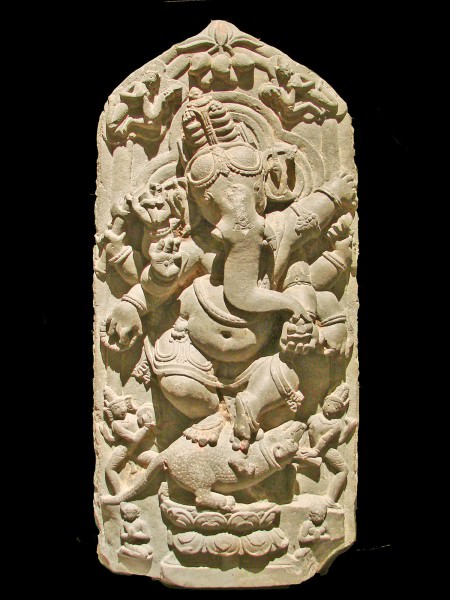
Ganesha
Continuing on his night-ride, Ganesha suddenly heard a thunderous noise from the heavens. This was the laughing of the Moon and his wives, the twenty seven Constellations, unable to contain themselves on seeing Ganesha wrapped in a snake.Outraged, Ganesha broke off the end of one of his tusks and hurled it at the laughing Moon who, hit full in the face, was struck black. Without the light of the moon, the dark nights became the haunt of thieves and villains until honest people had had enough and pleaded with the gods to restore the silver light. The gods asked Ganesha to forgive the Moon but only a partial forgiveness was given. Consequently, only periodically, on one night, would the Moon give his full light and then he would slowly waste away.
An alternative explanation of Ganesha's broken tusk is that of Krishna throwing his axe at Ganesha after he blocked his entrance to the private apartments of his parents Shiva and Parvati. Ganesha allowed the axe to hit and break his tusk so that no-one could say that the axe, which was in fact his father's, was not a fearsome weapon. Yet another but less picturesque explanation of Ganesha's broken tusk was that he snapped it off in order to transcribe the epic poem Mahabharata, dictated by the sage Vyasa who wished to preserve the story for all time. This version explains Ganesha's association with writers and intellectuals.
REPRESENTATION IN ART
In Hindu art Ganesha is variously portrayed depending on specific cultures - Indian, Cambodian, Javanese etc. but he is most often depicted with the head of an elephant and a rather portly human body. In his hands he often carries a broken tusk, an axe, a ladle, a noose, prayer beads and a tray of sweets. He sometimes also wields an elephant goad in order to master life's obstacles. Ganesha is often depicted riding Kroncha, his giant rat, famed for its agility and also symbolic of the god's ability to circumvent obstacles.
Roman Citizenship › Antique Origins
Ancient Civilizations
Citizenship is and always has been a valued possession of any individual. When one studies the majority of ancient empires one finds that the concept of citizenship, in any form, was non-existent. The people in these societies did not and could not participate in the affairs of their government. These governments were either theocratic or under the control of a non-elected sovereign, answerable to no one except himself. There was no representative body or elected officials. The Athenians were among the first societies to have anything remotely close to our present-day concept of citizenship. Later, the Romans created a system of government that sought the participation of its citizenry. Every citizen, women excluded, shared fully in all governmental activities with all of its rights, privileges, and responsibilities. It should be noted that Roman women were considered citizens; however, they had few, if any, legal rights.
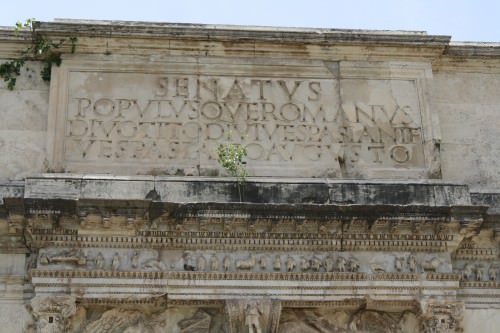
Inscription, Arch of Titus
CITIZENSHIP IN THE EARLY REPUBLIC
After the collapse of the old monarchy and the foundation of the Republic, the control of Roman government was restricted to a handful of great families - the patricians, a word derived from patres or 'fathers'. The remaining residents/citizens were called plebians, representing the poor as well as many of the city ’s wealthy. Soon, however, these plebians or plebs began to resent their second-class status and rose up, demanding to participate in the affairs of state and exercise their rights as full citizens of Rome. After the threat of a work stoppage became a reality, the resulting compromise - the “Conflict of Orders” - brought into creation the Concilium Plebis or Council of the Plebs. This representative body spoke for the plebians through a number of elected tribunes. It enacted laws that pertained initially to the plebians but eventually became binding to all citizens, including the patricians.
THE REWARD OF CITIZENSHIP MEANT THAT AN INDIVIDUAL LIVED UNDER THE “RULE OF LAW” AND HAD A VESTED INTEREST IN HIS GOVERNMENT.
During the early days of the Republic, the Roman government was established with the primary goal of avoiding the return of a king. Its authority centered on a number of elected magistrates (consuls, praetors, quaestors and aediles), a Senate, and a number of smaller assemblies. This new concept of citizenship, however, did not mean full equality. The differences between patrician and plebian still existed. In 450 BCE the creation of the Twelve Tables, the first Roman law code, established rules that governed, among other things, the relationship between the two classes. The reward of citizenship only meant that an individual lived under the “rule of law” and had a vested interest in his government. One must wonder why there was this desire to vote or, in other words, to be a true Roman ( civitas Romanus sum ) - that is to say proudly “I am a Roman citizen.”
SPQR
The notion of Roman citizenship can best be represented in the logo - seen on documents, monuments and even the standards of the Roman legion - SPQR or Senatus Populus Que Romanus, the Senate and Roman People. The historian Tom Holland, in his book Rubicon, wrote that the right to vote was a sign of a person's success. To be a Roman citizen an individual was educated to “temper” his “competitive instincts” for the good of the people. For the typical Roman, the concept of “ civitas ” meant that he had to not only share in the joys of self-government but also suffer along in its sorrows and fears.Even the poorest of Roman citizens, the proletarii, were still represented (albeit with little effect) in the comitia centuriata.
Aside from the fact that women, although citizens, had no share in the politics of Rome, there was an even larger but significant portion of the population that resided behind the wall of the city and was not granted the rights of citizenship - the slaves. Slavery was not uncommon in the ancient world and existed long before the Republic. It could be found in the empires of Assyria and Babylon as well as in Greece. As with other civilizations, in Rome, many of the slaves came from military conquests. Slavery allowed many of the wealthy citizens to participate in the politics of running the empire. Slaves served a variety of functions. They were farmers, miners, domestic servants, entertainers and even teachers. However, unlike the slaves of Greece, a Roman slave lived in a unique society: he could earn or buy his freedom or liberti and enjoy the benefits of citizenship, gaining wealth and power; his children could even hold public office.
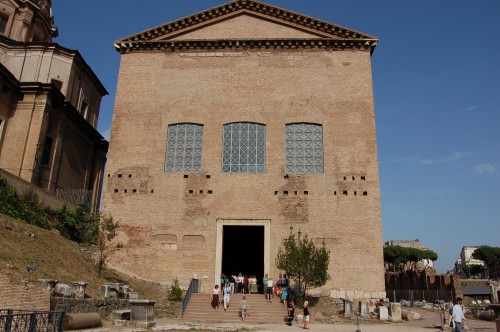
The Curia
EMPIRE: EXPANDING CITIZENSHIP
With the growth of Rome and its desire to extend its boundaries beyond the city walls, the concept of Roman citizenship changed. This growth begged the question: how were these newly conquered people to be treated? Were they to become Roman citizens? Were they to be considered equals? Despite the fact that Rome had always been a city of immigrants, the acquisition of citizenship for a resident of Rome was different for the person outside of Rome. As one historian stated, there was a difference between granting citizenship to an individual than to an entire people. After the conquest of the Latins and the Samnites, the questions of “rights” and “privileges” came into play.
While they continued to be citizens of their own communities, these new allies wanted the same freedoms as all Romans.Although they received many benefits from their position as an ally such as protection from invasion, a share of plunder from a military engagement and the ability to make economic agreements, they were not treated as true citizens of the Republic.There were disadvantages: they had to pay tribute to Rome as well as provide soldiers, indeed, by 100 BCE allies composed two-thirds of the Roman army. They subsisted in a vague second-class status called ius Latii. They had many of the benefits of a citizen but without representation in any of the city's assemblies. To be a true and equal citizen, in short, to be a Roman, an individual needed to exercise his right to vote.
A PROVINCIAL (A RESIDENT OF ONE OF THE PROVINCES) COULD RECEIVE CITIZENSHIP FOR HIS LOYALTY OR SERVICE TO THE STATE.
By the time of the invasion of Italy by the Carthaginian general Hannibal in the Second Punic War (218 – 201 BCE) there had been some minor changes - residents of these allied communities had gained the right of conubium where the child of a Roman father and provincial mother was considered a Roman - the child was no longer considered illegitimate. A provincial (a resident of one of the provinces) could receive citizenship for his loyalty or service to the state. Later, around 150 BCE, magistrates of these Latin towns or municipia acquired Roman citizenship. And, finally, any Latin who settled in the city of Rome could obtain citizenship.
As Rome acquired lands throughout the peninsula, tensions continued to grow in many of the communities outside Rome.These newly conquered people were demanding a change in their status. While they could intermarry with Romans, make contracts and had free movement - civitas sine suffragio or citizenship without the vote - they still demanded more. They wanted what the citizens of the city had: optimo iure or citizenship with the vote. The tribune Gaius Gracchus (122 -121 BCE) made a proposal that would have granted full citizenship to all of the Italian allies. Gaius, unfortunately, faced opposition from the most unlikely of allies - the nobility and the plebians - the latter feared the competition for food and jobs. Unfortunately, Gaius's other reform suggestions made him popular with some but the enemy of others (the Roman Senate ). His death and the murder of 3,000 of his followers put an end to his proposition.
THE SOCIAL WARS
Change, however, was on the horizon. The Social Wars, or War of the Allies, would alter the status of the allies. While his fellow Romans in the Senate were making further attempts at restricting citizenship for the allied communities, the tribune M. Livius Drusus was proposing to grant them full and equal citizenship. In 91 BCE his assassination initiated the Social Wars (91 – 89 BCE) - one of the deadliest in all of Roman history. The Etruscans and Umbrians were threatening to secede. Riots and unrest (even outside the Italian peninsula) soon followed. The Senate told the populace that if these people became citizens they would overrun the city. However, calmer minds prevailed and as a result, full citizenship was finally granted to all people (slaves excluded) in the entire Italian peninsula (at least initially) for those who had not taken up arms against Rome. Later, Julius Caesar, the dictator for life, would extend citizenship beyond Italy and grant it to the people of Spain and Gaul.
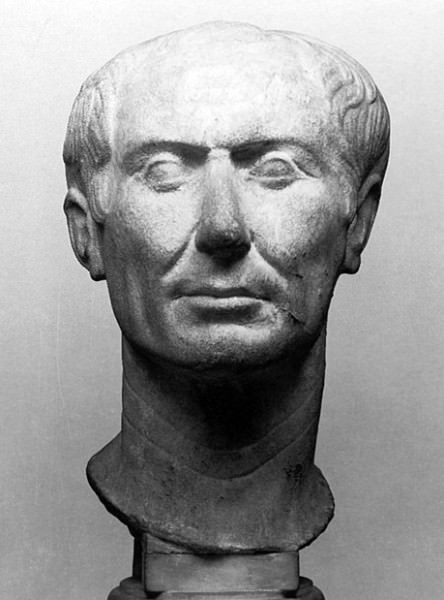
Bust of Julius Caesar
CITIZENSHIP: DOMINANCE OF THE WEALTHY
The definition of what is was to be Roman was changing; in fact, the idea of what was “Latin” was becoming, as one historian expressed, less ethnic and more political. And, in Rome, many of the old questions arose such as how were the existing institutions to deal with these new citizens. These new citizens were to learn what it was to be called a Roman. Historian Tom Holland said that to be a Roman citizen meant that a person realized that he was truly free. However, there were stipulations placed on this new citizenship. The Roman citizen, whether inside or outside the city, must put aside the sense of the individual and focus on the good of the community.
In actuality, the acquisition of the right to vote by those outside the city had little meaning to all but the wealthy. Membership in the Roman assemblies was not done by election - it was a direct democracy. Voting was done by tribes, and all citizens were assigned to a particular tribe (often based on wealth) where each tribe voted as one. However, to vote a person had to appear in person which was something only the wealthy could afford to do. But citizenship was not eternal. If necessary, an individual's citizenship could be revoked; this latter condition was mostly reserved for criminals.
Every five years a citizen had to register himself at the Villa Publica for the census, declaring the name of his wife, the number of children, and all of his property and possessions (even his wife's clothes and jewels were declared). Every Roman citizen believed the government had a right to know this information. All of this data was reviewed and evaluated by the city's magistrates (censors) who could “promote or demote each citizen according to his worth.” Tom Holland wrote on the value of the census, “Classes, centuries, and tribes, everything that enabled a citizen to be placed by his fellows, were all defined by the census.”
By 212 CE the Emperor Marcus Aurelius Antonius, better known as Caracalla, took steps to make all male residents of the empire full citizens (the women in these areas had the same rights as Roman women); this proposal was called the Constitutio Antoniniana. Many historians question the rationale for this sudden benevolent act. Some believe that he needed more tax revenue, and since only Roman citizens paid an inheritance tax, his purpose was clear. But in practice, by the early 3rd century CE the idea of citizenship and the “right to vote” was mostly irrelevant. The duties of the emperor replaced the function of both the Senate and assemblies and voting rights were all but non-existent. In its place Rome became divided between two groups - the honestiores or the elite and the humilores, the lower sort - there was actually no legal distinction between the two classes. Citizenship had always meant that an individual had a role in the affairs of state, but with the assassination of Caesarand the rise to power of his step-son Augustus - who the Senate awarded the title of the first citizen or princeps - the government was forever changed in Rome. Citizenship was no longer the prized possession that it once had been.
LICENSE:
Article based on information obtained from these sources:with permission from the Website Ancient History Encyclopedia
Content is available under License Creative Commons: Attribution-NonCommercial-ShareAlike 3.0 Unported. CC-BY-NC-SA License